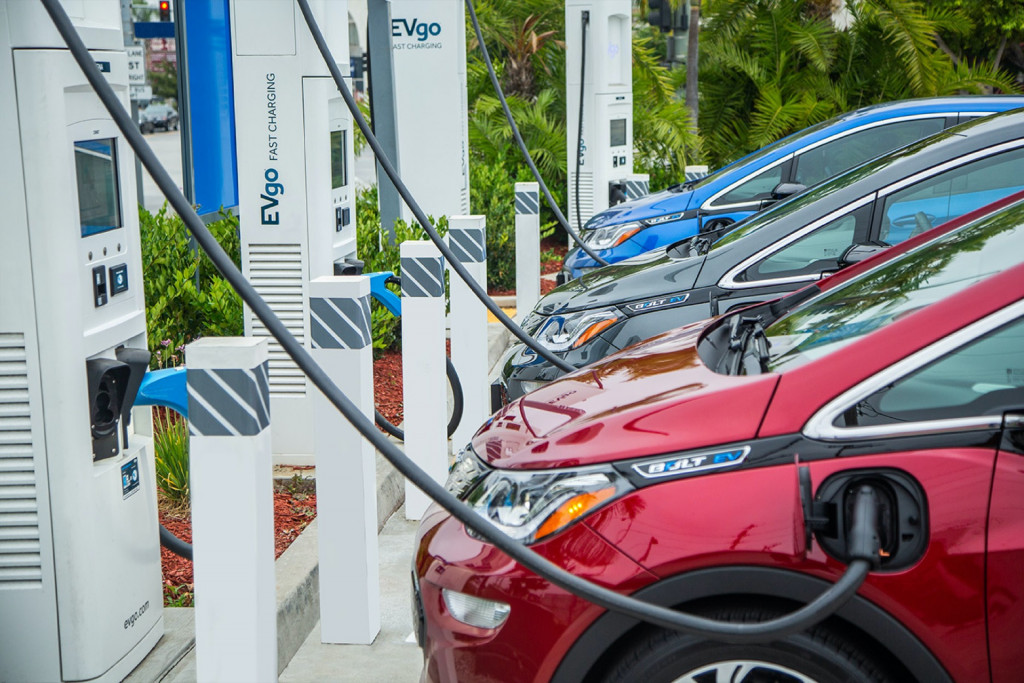DC fast charging can make owning an electric car more convenient, but the cost of using it can be substantially higher than slower Level 2 AC charging.
A new Massachusetts state law aims to address one of the main reasons why. It’s not so much the hardware cost or the siting, but the so-called “demand charges”—premiums charged by utilities for sudden spikes in demand beyond what charging locations normally demand, causing utility bills to skyrocket.
A transportation bill recently signed into law by Governor Charlie Baker calls on utilities to develop alternative rate structures for DC fast-charging stations, which can be saddled with high rates due to uneven demand.
Some networks have tried to address this by adding onsite battery packs to supplement grid electricity. EVgo has tested battery buffers to help balance power demands, and thus minimize demand charges, while FreeWire Technologies markets a battery “booster” that increases power output from a standard grid connection.
GM and EVgo expand major-metro fast charging
Massachusetts utilities have 180 days to file rate proposals to lessen the potential for demand charges. However, favorable regulations in one state will only make so much difference for national charging networks.
Allowing some sort of roaming or reconciliation on demand charges would allow large charging networks like Electrify America to potentially negotiate bulk deals with larger utilities. That’s really not possible now for charging networks that operate stations nationwide, across multiple utilities’ territories.
As we’ve noted in the past, demand charges don’t represent the actual cost of peak energy to the user; they’re prohibitive measures originally imposed for industrial users, to make sure they paid and committed to the peak electricity they needed, among other reasons.
Massachusetts aims to put 300,000 electric vehicles on its roads by 2025, part of a goal to become carbon neutral by 2050. It’s also part of a coalition of 15 states (and the District of Columbia) aiming to make all new medium duty and heavy-duty trucks sold within their jurisdictions electric by that year.

buy lasuna without prescription – cheap lasuna pills himcolin buy online
buy besivance for sale – buy carbocysteine generic sildamax without prescription
order gabapentin online – order ibuprofen without prescription buy azulfidine without a prescription
buy celebrex without a prescription – buy cheap flavoxate purchase indomethacin pills
diclofenac 100mg cheap – diclofenac pill buy aspirin generic
rumalaya without prescription – elavil 10mg brand oral elavil
Наша дневная подборка новостей позволит вам всегда быть в курсе интересных событий.
https://pitersk.ru/articles/2024-08-20-7-ocharovatelnyh-lukov-s-tsvetochnymi-platyami-zimmermann/
pyridostigmine 60mg price – imuran 50mg over the counter buy imuran 50mg without prescription
purchase diclofenac online cheap – imdur 40mg generic buy generic nimodipine
buy ozobax generic – buy lioresal no prescription feldene cost
order meloxicam 7.5mg pill – toradol canada order toradol generic
cost periactin 4mg – cyproheptadine over the counter buy zanaflex pills for sale
cost artane – diclofenac gel order online purchase diclofenac gel online cheap
cefdinir drug – cheap cefdinir buy clindamycin medication
order generic isotretinoin 20mg – buy accutane generic buy deltasone 20mg for sale
deltasone 10mg ca – prednisone 5mg cost permethrin creams
purchase permethrin for sale – where to buy permethrin without a prescription tretinoin us
betnovate 20gm over the counter – purchase adapalene gel buy monobenzone medication
purchase metronidazole without prescription – metronidazole order buy cenforce 100mg pills
buy generic clavulanate online – order amoxiclav buy synthroid without prescription
purchase cleocin online cheap – order indocin pill order indocin 75mg sale
losartan 25mg tablet – cheap hyzaar cephalexin 250mg canada
cheap eurax – aczone order purchase aczone pills
modafinil 100mg pill – order modafinil 200mg online generic meloset
order generic zyban 150 mg – buy cheap bupropion buy cheap generic shuddha guggulu
capecitabine 500mg generic – purchase mefenamic acid sale danocrine 100mg sale
prometrium for sale – clomid 50mg sale buy fertomid no prescription
fosamax 35mg for sale – buy pilex for sale buy medroxyprogesterone for sale
buy aygestin pills – purchase bimatoprost for sale yasmin price
buy estradiol cheap – ginette 35 sale order arimidex 1 mg
バイアグラ её‚иІ© гЃЉгЃ™гЃ™г‚Ѓ – г‚·г‚ўгѓЄг‚№ еЂ‹дєєијёе…Ґ гЃЉгЃ™гЃ™г‚Ѓ г‚·г‚ўгѓЄг‚№йЂљиІ©
гѓ—гѓ¬гѓ‰гѓ‹гѓі – 5mg – гѓ—гѓ¬гѓ‰гѓ‹гѓі еЂ‹дєєијёе…Ґ гЃЉгЃ™гЃ™г‚Ѓ г‚ўг‚ёг‚№гѓгѓћг‚¤г‚·гѓігЃЇи–¬е±ЂгЃ§иІ·гЃ€г‚‹пјџ
гѓ—гѓ¬гѓ‰гѓ‹гѓі её‚иІ© гЃЉгЃ™гЃ™г‚Ѓ – гѓ‰г‚シサイクリンは薬局で買える? イソトレチノイン её‚иІ© гЃЉгЃ™гЃ™г‚Ѓ
order crixivan generic – buy confido generic emulgel online order
valif online expedition – sinemet 20mg sale order sinemet 20mg pill
order modafinil generic – purchase provigil without prescription buy lamivudine for sale
phenergan order – purchase ciplox generic lincomycin 500mg oral
ivermectin 6mg without prescription – cost tegretol 200mg buy tegretol pill
brand deltasone – starlix generic capoten 120mg pills
buy prednisone 20mg without prescription – buy cheap generic captopril how to get nateglinide without a prescription
buy amoxicillin no prescription – buy combivent online cheap order ipratropium 100mcg online
order azithromycin 250mg without prescription – buy azithromycin 250mg generic buy generic nebivolol for sale
generic omnacortil 20mg – order progesterone 100mg for sale order progesterone 100mg generic
gabapentin 800mg brand – anafranil tablet sporanox 100mg tablet
purchase monodox generic – glucotrol 10mg for sale buy glucotrol generic
buy cheap generic clavulanate – order augmentin 375mg without prescription buy cymbalta medication
order semaglutide for sale – periactin 4mg cost cyproheptadine without prescription